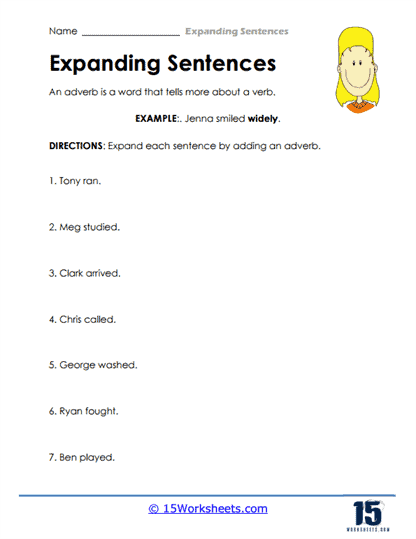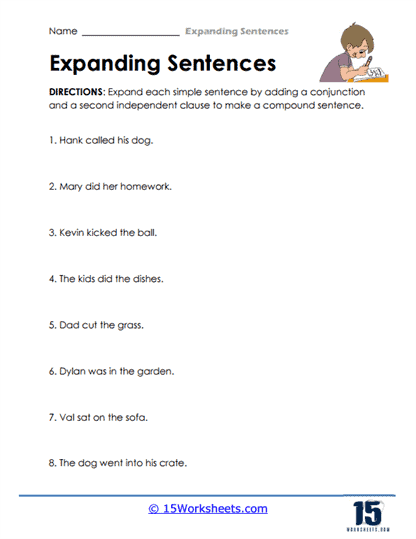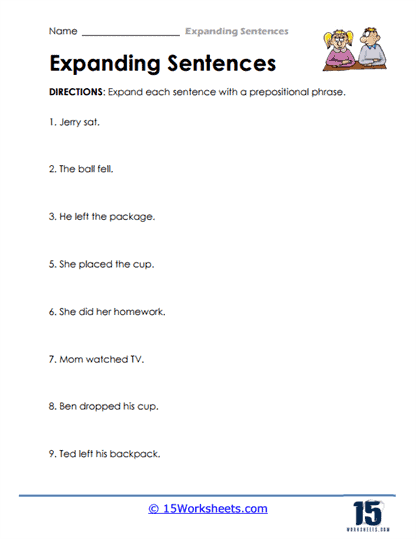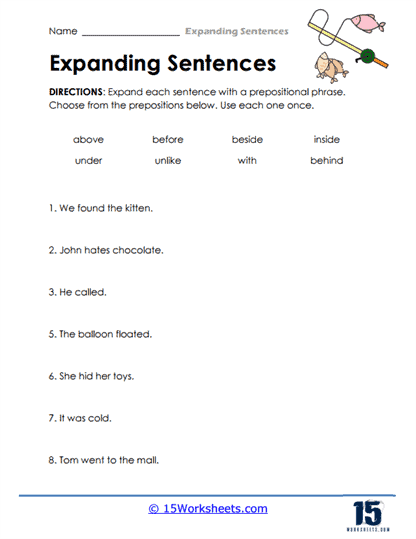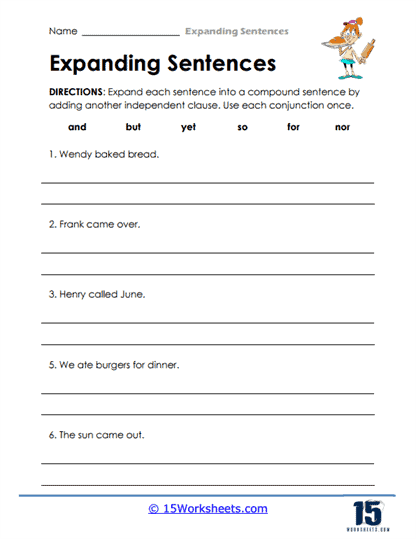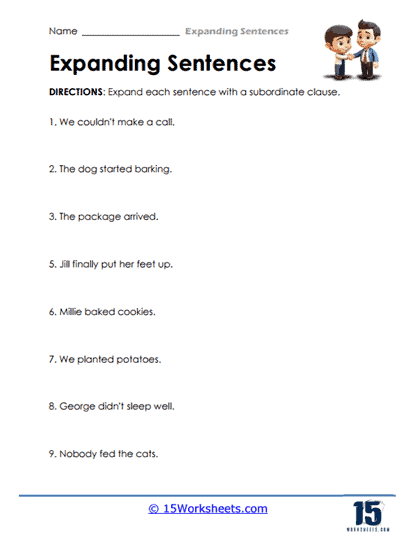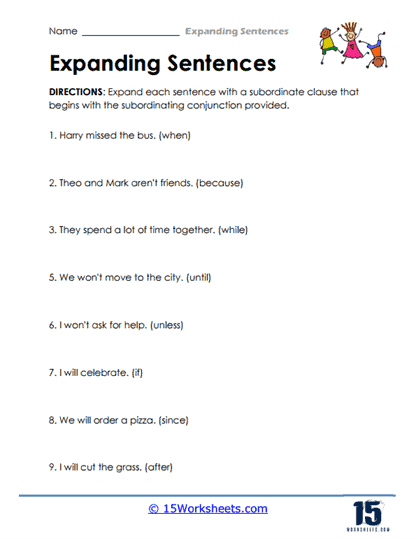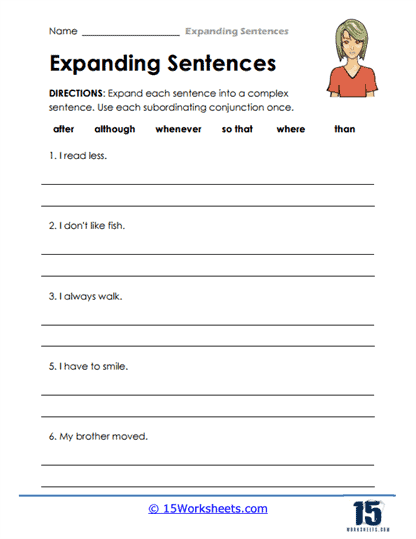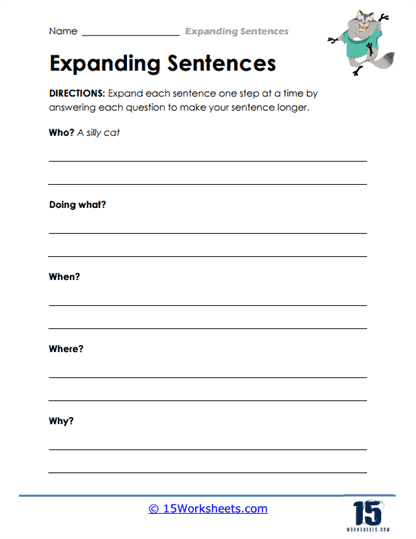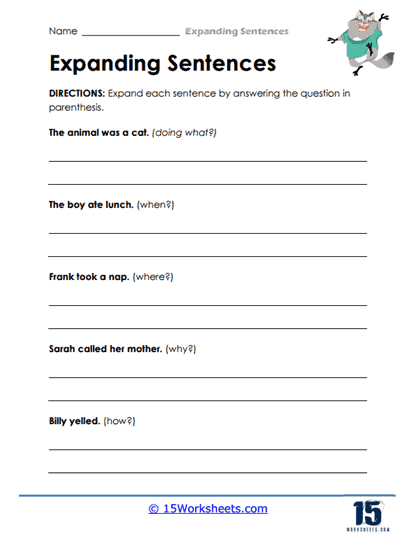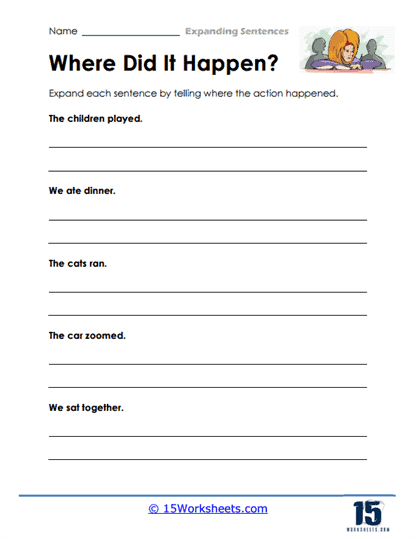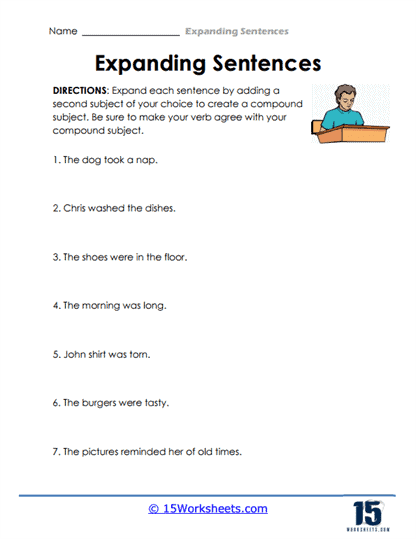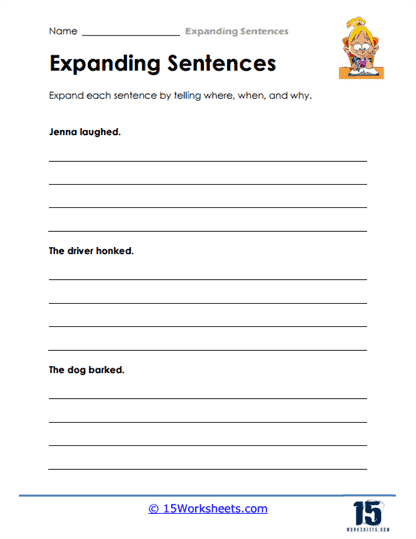Expanding Sentences Worksheets
All About These 15 Worksheets
Imagine you have a tiny seed. If you give it water, sunlight, and love, it’ll grow into a big, beautiful plant. Now, think of a simple sentence as that tiny seed. “Expanding Sentences Worksheets” are like the water, sunlight, and love that help your sentence-seed grow and flourish!
These worksheets help you add more details, feelings, and action to your sentences. Instead of saying, “The cat sat,” you could say, “The fluffy white cat sat lazily on the sunny windowsill.” See the difference? The second sentence paints a much clearer picture in your mind, doesn’t it?
Different Types of Activities on the Worksheets
Adding Adjectives – Adjectives are colorful words that describe things. You might get a sentence like “The dog barked” and be asked to add adjectives. You could change it to “The loud, brown dog barked.”
Inserting Adverbs – Adverbs are words that tell us how something is done. For the sentence, “She sang,” you could add an adverb to make it “She sang beautifully.”
Including Feelings – Feelings add emotion to a sentence. Starting with “He opened the gift,” you could expand it to “He opened the gift with excitement.”
Adding Where and When – Telling when and where something happens gives more information. “Birds chirped” can become “Birds chirped in the big oak tree this morning.”
Using Better Verbs – Sometimes, a stronger action word makes a sentence more interesting. Instead of “The horse moved,” you could say, “The horse galloped.”
Combining Sentences – This is when you take two simple sentences and join them to make one detailed sentence. For example, “She read a book. It was scary.” can become “She read a scary book.”
Why Is Learning to Expand Sentences Important?
Painting a Picture with Words – When you add more details to your sentences, you create a vivid picture in the reader’s mind. It’s like turning a black and white sketch into a colorful painting.
Telling Better Stories – Whether you’re writing a story, an essay, or just talking with friends, expanded sentences make your tales more exciting and engaging.
Expressing Feelings – By expanding your sentences, you can better express how you or a character feels, making your writing more emotional and relatable.
Becoming a Word Wizard – The more you practice expanding sentences, the better you get at using different words. This will make you a real word wizard!
In your everyday adventures, expanded sentences can make a difference. Imagine telling your family about your day at school. Instead of saying, “I played,” you could say, “I played an exciting game of tag with my best friends during recess.” Which one sounds more fun to listen to?
How to Create Better Sentences
Expanding a sentence to make it more engaging involves adding details, utilizing descriptive language, and considering the overall rhythm and flow of the sentence. Here are some steps to guide you through the process:
Identify the Basic Elements – Start by pinpointing the subject, verb, and object in the sentence. For instance, in the sentence “The bird sang,” “bird” is the subject, “sang” is the verb, and there isn’t a specific object mentioned.
Add Adjectives – Use adjectives to describe the subject and object. Think about their color, size, texture, or any other distinctive feature. The sentence becomes, “The bright blue bird sang.”
Incorporate Adverbs – Adverbs can provide more detail about the verb. How did the action happen? Was it done quickly, slowly, happily, or sadly? “The bright blue bird sang beautifully.”
Include Feelings or Emotions – By adding emotions, you give depth to the subject or the overall mood of the sentence. “The bright blue bird sang beautifully, filling the air with joy.”
Provide Context with Where and When – Setting can make a big difference. When and where did this action take place? “The bright blue bird sang beautifully in the old oak tree at dawn.”
Use Specific Details or Names – Instead of general terms, specify what or who you are talking about. “The bright blue canary sang beautifully in the old oak tree at dawn.”
Incorporate Stronger Verbs – A potent verb can breathe life into a sentence. Instead of using common verbs, find a more dynamic synonym. “The bright blue canary trilled beautifully in the old oak tree at dawn.”
Combine Sentences – If you have multiple short sentences that relate to the same idea, combine them for a more engaging narrative. “The bright blue canary trilled beautifully in the old oak tree at dawn, while the sun painted the sky with shades of pink and gold.”
Check for Flow and Rhythm – After expanding, read your sentence aloud. Does it sound smooth? Is there a pleasant rhythm to it? If something feels off, consider rearranging the words or replacing some for better flow.



